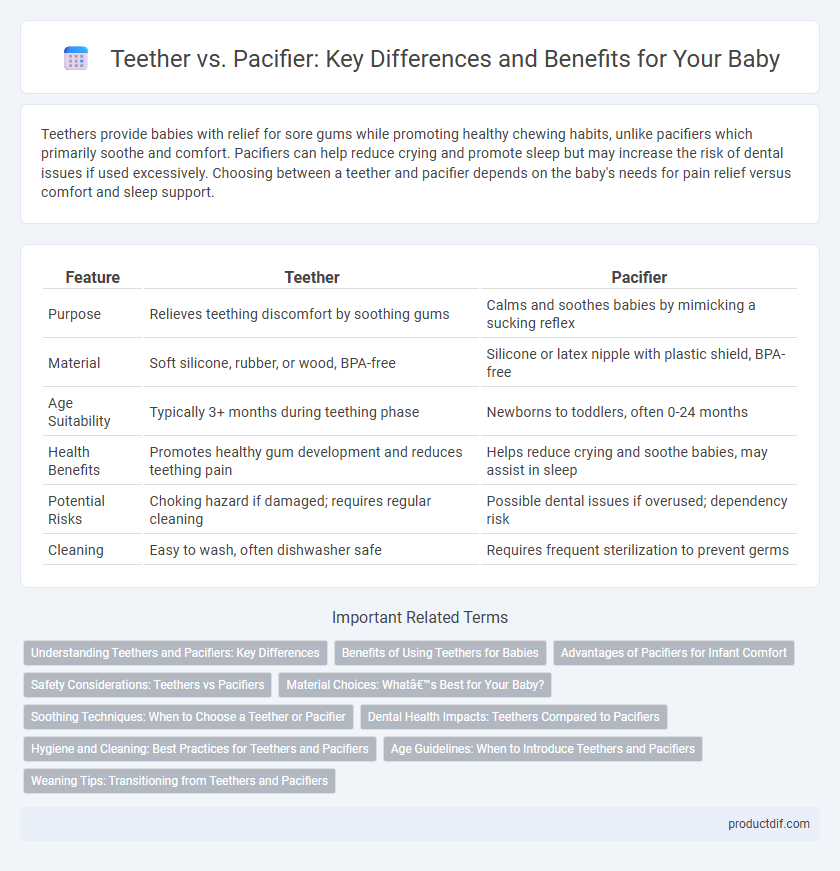Teethers provide babies with relief for sore gums while promoting healthy chewing habits, unlike pacifiers which primarily soothe and comfort. Pacifiers can help reduce crying and promote sleep but may increase the risk of dental issues if used excessively. Choosing between a teether and pacifier depends on the baby's needs for pain relief versus comfort and sleep support.
Table of Comparison
| Feature | Teether | Pacifier |
|---|---|---|
| Purpose | Relieves teething discomfort by soothing gums | Calms and soothes babies by mimicking a sucking reflex |
| Material | Soft silicone, rubber, or wood, BPA-free | Silicone or latex nipple with plastic shield, BPA-free |
| Age Suitability | Typically 3+ months during teething phase | Newborns to toddlers, often 0-24 months |
| Health Benefits | Promotes healthy gum development and reduces teething pain | Helps reduce crying and soothe babies, may assist in sleep |
| Potential Risks | Choking hazard if damaged; requires regular cleaning | Possible dental issues if overused; dependency risk |
| Cleaning | Easy to wash, often dishwasher safe | Requires frequent sterilization to prevent germs |
Understanding Teethers and Pacifiers: Key Differences
Teethers are designed to soothe a baby's gums during teething by providing a safe surface to chew on, often made from silicone or rubber and free of harmful chemicals. Pacifiers serve mainly to satisfy a baby's natural sucking reflex and provide comfort, typically made with a nipple-shaped silicone or latex part that mimics breastfeeding. Understanding the materials, purpose, and usage of teethers versus pacifiers helps parents choose the right product for their infant's developmental needs and soothing preferences.
Benefits of Using Teethers for Babies
Teethers provide soothing relief for babies by massaging sore gums during the teething process, which helps reduce discomfort and irritability. They promote healthy oral development by encouraging chewing and jaw muscle strengthening without the risks associated with prolonged pacifier use. Safe, non-toxic materials in modern teethers also support sensory exploration and fine motor skill development in infants.
Advantages of Pacifiers for Infant Comfort
Pacifiers provide soothing relief by satisfying a baby's natural sucking reflex, helping to calm and comfort infants effectively. They reduce the risk of sudden infant death syndrome (SIDS) by promoting better sleep patterns and encouraging self-soothing. Unlike teethers, pacifiers offer continuous sucking satisfaction, which can help reduce fussiness and support emotional regulation during stressful moments.
Safety Considerations: Teethers vs Pacifiers
Teethers are designed with non-toxic, BPA-free materials that withstand chewing without breaking apart, reducing choking hazards and promoting safe sensory exploration for infants. Pacifiers must meet strict safety standards, including ventilation holes and one-piece construction to prevent swallowing or suffocation risks, with regular inspection advised for wear and tear. Parents should choose products that comply with ASTM or CPSIA regulations and replace items frequently to maintain optimal safety for their babies.
Material Choices: What’s Best for Your Baby?
Choosing the right material for teethers and pacifiers significantly impacts your baby's safety and comfort. Silicone is widely preferred for its non-toxic, BPA-free properties and durability, while natural rubber offers a softer, eco-friendly alternative. Avoid PVC or latex materials to reduce the risk of allergies and harmful chemical exposure in infant products.
Soothing Techniques: When to Choose a Teether or Pacifier
Teethers are ideal for soothing babies during the teething phase, providing relief through chewing that helps massage sore gums and promote oral development. Pacifiers offer comfort by satisfying the baby's natural sucking reflex, often calming fussiness and aiding sleep. Choosing between a teether or pacifier depends on whether the baby needs gum relief or emotional comfort, making it essential to identify the primary source of discomfort.
Dental Health Impacts: Teethers Compared to Pacifiers
Teethers promote healthy oral development by encouraging natural chewing motions that strengthen jaw muscles and soothe gums, while pacifiers may contribute to dental malocclusions such as open bites or misaligned teeth if used extensively. Research indicates that prolonged pacifier use beyond age two increases the risk of dental issues, whereas teethers designed with safe materials support gum stimulation without negatively affecting tooth alignment. Choosing BPA-free, FDA-approved teethers can enhance infant dental health by reducing pacifier-associated risks.
Hygiene and Cleaning: Best Practices for Teethers and Pacifiers
Teethers and pacifiers require regular cleaning to prevent bacteria buildup and ensure infant safety. Use mild soap and warm water or sanitize by boiling for at least five minutes to maintain hygiene. Avoid harsh chemicals and check for wear to replace items promptly, reducing the risk of infection.
Age Guidelines: When to Introduce Teethers and Pacifiers
Teethers are generally recommended for babies around 3 to 6 months old when they begin teething and need soothing for sore gums, while pacifiers can be introduced earlier, often from birth, to help with soothing and sucking reflex. Pediatricians advise limiting pacifier use after 6 months to reduce potential risks to dental development and encourage natural feeding habits. Choosing the right age to introduce each depends on the baby's developmental stage and comfort needs, with teethers supporting gum relief and pacifiers aiding in calming and sleep routines.
Weaning Tips: Transitioning from Teethers and Pacifiers
Gradually reduce the use of teethers and pacifiers by introducing comfort objects like soft toys or blankets to ease the weaning process. Encourage self-soothing techniques during nap and bedtime to help your baby adjust without reliance on pacifiers or teethers. Consistent routines and positive reinforcement strengthen the transition and minimize resistance.
Teether vs Pacifier Infographic

 productdif.com
productdif.com